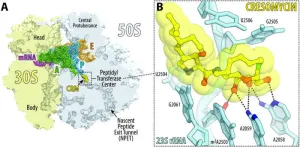(Press-News.org) Why do Serengeti zebra, wildebeest, and gazelle – all sharing limited food resources – follow the same migratory routes, one after another, in a body-size dependent way? This longstanding question has now been evaluated by researchers who used novel data to show how a balance of species interactions and ecological factors regulate this process. They say competition pushes zebra ahead of the wildebeest, and wildebeest then eat plants in a way that facilitates development of newer growth the trailing gazelle like. “Our results highlight a balance between facilitative and competitive forces,” the authors say. Large seasonal migrations are a defining feature of many marine and terrestrial ecosystems. The migration of large herbivores in Serengeti National Park – an annual event involving nearly 2 million animals – is a classic example of body-size-dependent “grazing succession,” in which zebra (~230 kilograms), wildebeest (~180 kilograms), and gazelle (~20 kilograms) sequentially follow the same migratory routes one after another. Although migration is common in large mammalian herbivore species, the ecological dynamics underlying large migrations involving several species all sharing limited food resources remain poorly understood. Several explanations of this sequential pattern have been proposed, including competition, facilitation, and predation. However, disentangling the potential mechanisms that drive these migratory grazers’ movement and foraging behaviors has been challenged by a lack of long-term, detailed data.
Michael Anderson and colleagues conducted an analysis of animal movements in the Serengeti using data from an 8-year camera-trap survey, GPS-collared animal tracking data, and fecal DNA metabarcoding to characterize the timing, arrival, and interactions between zebra, wildebeest, and gazelle. Anderson et al. discovered that the observed patterns of grazing succession were driven by both competition and facilitation and characterized by a “push-and-pull” dynamic centered on the dominant grazer, wildebeest. According to the findings, competition for food “pushes” zebra ahead of the larger herds of wildebeest during migratory succession. As the wildebeest move along, they reduce grass biomass and facilitate the development of newer growth, “pulling” along gazelle who take advantage of the new food as they trail the other two species. There was no evidence that predation played any role in grazing succession. What’s more, Anderson et al. leveraged observations of intense wildfires and rainfall in the region and found that these events, respectively, strengthen successional grazing patterns.
END
Unearthed: Why zebra go first in body-size-dependent grazing succession in the Serengeti
2024-02-15
ELSE PRESS RELEASES FROM THIS DATE:
Oxygen increased in the tropical ocean during the Paleocene-Eocene Thermal Maximum
2024-02-15
Oxygenation in the tropical North Pacific Ocean increased during a warm climatic interval that occurred roughly 56 million years ago, despite high global temperatures, according to a new study. Its findings offer insights into how modern tropical oceans may respond to ongoing anthropogenic climate warming. The availability and distribution of dissolved oxygen in Earth’s oceans play a fundamental role in supporting marine ecosystems and marine life. However, oxygen in the global oceans is declining in response to anthropogenic warming. Although these trends writ large are predicted to continue, the future of oxygen in the highly productive ...
Introducing Cresomycin, a synthetic antimicrobial molecule highly effective against multidrug-resistant bacteria
2024-02-15
Cresomycin – a novel synthetic molecule – demonstrates remarkably robust efficacy against multiple, evolutionary divergent forms of antimicrobial resistance (AMR), researchers report. The emergence and widespread distribution of bacteria broadly resistant to approved antibiotics raises serious global public health concerns. Given the growing rate of deaths attributable to antimicrobial resistance (AMR) worldwide, it’s evident the pace of discovery and development of antibiotics effective against AMR has not kept up with the need. Many small ...
Prizewinner’s research unveils STING as a pivotal immune sensor channel
2024-02-15
For his work in furthering the understanding of how the human immune system senses dangerous invading pathogens, Bingxu Li has received the 2024 Michelson Philanthropies & Science Prize for Immunology. Li’s prize-winning essay investigates the role that Stimulator of Interferon Genes, or STING, plays in including multiple distinct defenses against viruses, bacteria, and tumors and in orchestrating myriad downstream responses upon activation – resolving a significant mystery in the field of innate immunity. The sensing and clearance of invading pathogens ...
Researchers observe highly excited ‘roaming’ energy pathway in chemical reactions
2024-02-15
Scientists have observed so-called 'roaming' chemical reactions, those that at certain points move away from the lowest minimum energy 'path of least resistance', in highly excited energy states for the first time.
Chemical reactions are supposed to occur along their minimum energy paths. In recent years, so-called roaming reactions that stray far from this path have begun to be observed, but only for chemical species in their ground state or, at most, their first excited state. However, researchers have now observed a roaming reaction even in highly excited energy states.
The researchers ...
MSU, Carnegie Science introduce a big new idea with the help of tiny plankton
2024-02-15
Researchers at Michigan State University and the Carnegie Institution for Science have developed a model that connects microscopic biology to macroscopic ecology, which could deepen our understanding of nature’s laws and create new opportunities in ecosystem management.
Reporting in the journal Science on Feb. 16, the team showed how microscopic relationships in plankton — such as between an organism’s size and nutrient consumption — scales up to predictably affect food webs.
“Using data that other researchers have measured at the microscale about these organisms, our model can predict what’s happening at the scale of whole ecosystems,” said Jonas ...
First-ever atomic freeze-frame of liquid water
2024-02-15
RICHLAND, Wash.—In an experiment akin to stop-motion photography, scientists have isolated the energetic movement of an electron while “freezing” the motion of the much larger atom it orbits in a sample of liquid water.
The findings, reported today in the journal Science, provide a new window into the electronic structure of molecules in the liquid phase on a timescale previously unattainable with X-rays. The new technique reveals the immediate electronic response when a target is hit with an X-ray, an important step in understanding the effects of radiation exposure on objects and people.
“The chemical reactions induced by radiation ...
Superbug killer: New synthetic molecule highly effective against drug-resistant bacteria
2024-02-15
A new antibiotic created by Harvard researchers overcomes antimicrobial resistance mechanisms that have rendered many modern drugs ineffective and are driving a global public health crisis.
A team led by Andrew Myers, Amory Houghton Professor of Chemistry and Chemical Biology, reports in Science that their synthetic compound, cresomycin, kills many strains of drug-resistant bacteria, including Staphylococcus aureus and Pseudomonas aeruginosa.
“While we don’t yet know whether cresomycin and drugs like it are safe ...
With just a little electricity, MIT researchers boost common catalytic reactions
2024-02-15
CAMBRIDGE, MA — A simple technique that uses small amounts of energy could boost the efficiency of some key chemical processing reactions, by up to a factor of 100,000, MIT researchers report. These reactions are at the heart of petrochemical processing, pharmaceutical manufacturing, and many other industrial chemical processes.
The surprising findings are reported today in the journal Science, in a paper by MIT graduate student Karl Westendorff, professors Yogesh Surendranath and Yuriy Roman-Leshkov, and two others.
“The results are really striking,” says Surendranath, a professor of chemistry ...
Keeping telomerase in check
2024-02-15
The natural ends of chromosomes appear alarmingly like broken DNA, much as a snapped spaghetti strand is difficult to distinguish from its intact counterparts. Yet every cell in our bodies must have a way of differentiating between the two because the best way to protect the healthy end of a chromosome also happens to be the worst way to repair damaged DNA.
Consider the enzyme telomerase, which is responsible for maintaining protective telomeres at the natural ends of chromosomes. Were telomerase to seal off a broken strand of DNA with a telomere, it would prevent further repair of that break and delete essential genes. Now, a new study in Science describes how cells avoid ...
Competition for food drives the planet’s remaining mass migration of herbivores
2024-02-15
Upending the prevailing theory of how and why multi-species mass-migration patterns occur in Serengeti National Park, researchers from Wake Forest University have confirmed that the millions-strong wildebeest population pushes zebra herds along in competition for the most nutrient-dense grasses.
The study resulting from this research, “Interplay of competition and facilitation in grazing succession by migrant Serengeti herbivores,” appears today in the peer-reviewed journal Science.
For decades, biologists have believed the major grazing ...



